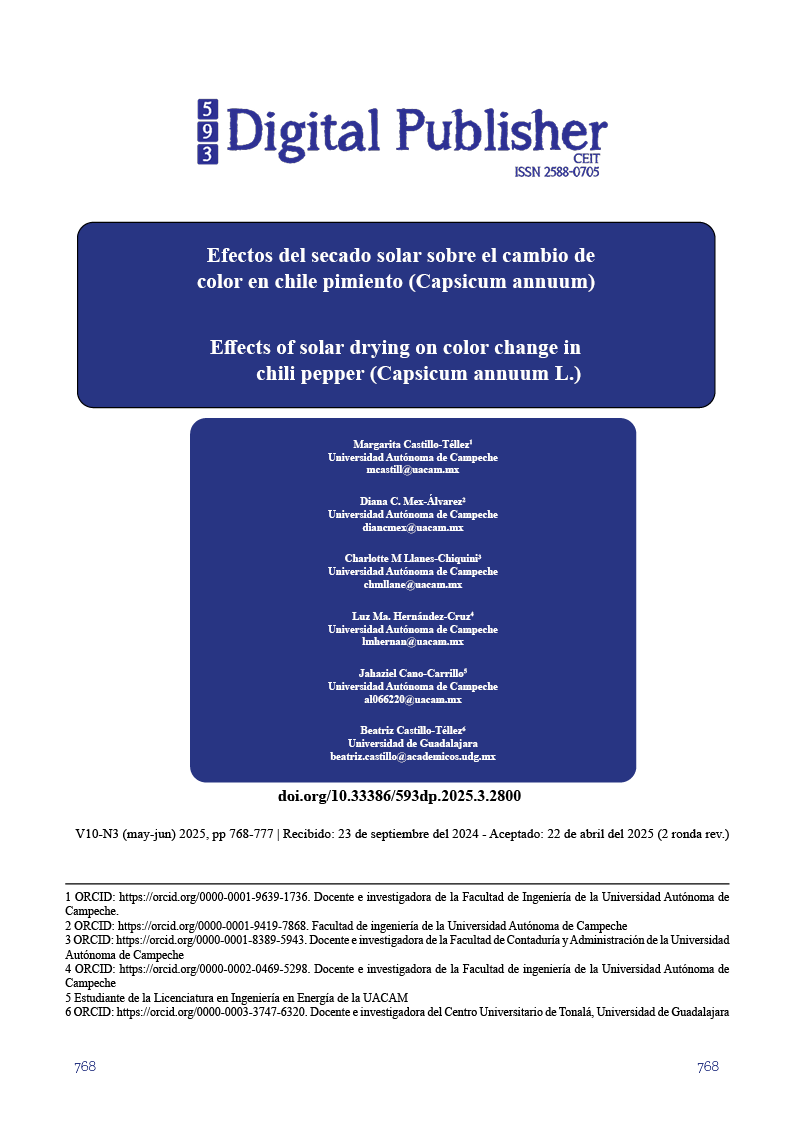Effects of solar drying on color change in chili pepper (Capsicum annuum L.)
Main Article Content
Abstract
The pepper, considered a fruit, has a fluffy texture and comes in various colors, such as red, green, yellow, and orange, each with various properties and flavors. In this study, experimental research was carried out on the solar drying of pepper peppers of different colors: red, green, yellow, and orange, using direct drying methods, such as drying in the open air, in the cabinet with natural convection, and the cabinet with forced convection. The objective was to analyze the impact of drying on the color of each variety by evaluating it in the CIELAB system. The results showed that drying rates were similar regardless of the color of the chili—however, forced convection drying preserved color better than natural convection drying, resulting in further color degradation. The values of L*, a*, and b* revealed that the open-dried green pepper acquired a dark, dry green color, the yellow pepper showed dark yellow to brown colors, the red pepper turned a dark reddish tone, and the orange pepper obtained an opaque color close to light browns. Among the different methods evaluated, the yellow pepper maintained its color better. The tests were carried out at the Faculty of Engineering of the Autonomous University of Campeche, in a hot and humid climate, located between parallels 17°49' and 20°51' north latitude and meridians 89°06' and 92°27' west longitude.
Downloads
Article Details

This work is licensed under a Creative Commons Attribution-NonCommercial-ShareAlike 4.0 International License.
1. Derechos de autor
Las obras que se publican en 593 Digital Publisher CEIT están sujetas a los siguientes términos:
1.1. 593 Digital Publisher CEIT, conserva los derechos patrimoniales (copyright) de las obras publicadas, favorece y permite la reutilización de las mismas bajo la licencia Licencia Creative Commons 4.0 de Reconocimiento-NoComercial-CompartirIgual 4.0, por lo cual se pueden copiar, usar, difundir, transmitir y exponer públicamente, siempre que:
1.1.a. Se cite la autoría y fuente original de su publicación (revista, editorial, URL).
1.1.b. No se usen para fines comerciales u onerosos.
1.1.c. Se mencione la existencia y especificaciones de esta licencia de uso.
References
Amjad, W., Ali Gilani, G., Munir, A., Asghar, F., Ali, A., & Waseem, M. (2020). Energetic and exergetic thermal analysis of an inline-airflow solar hybrid dryer. Applied Thermal Engineering, 166. https://doi.org/10.1016/j.applthermaleng.2019.114632
Arslan, D., & Özcan, M. M. (2011). Dehydration of red bell-pepper (Capsicum annuum L.): Change in drying behavior, colour and antioxidant content. Food and Bioproducts Processing, 89(4), 504–513. https://doi.org/10.1016/j.fbp.2010.09.009
Castillo T., M., Castillo T., B., Viviana, M. M. E., & Carlos, O. S. J. (2018). Technical and Experimental Study of the Solar Dehydration of the Moringa Leaf and Its Potential Integration to the Sustainable Agricultural Industry. European Journal of Sustainable Development, 7(3), 65–73. https://doi.org/10.14207/ejsd.2018.v7n3p65
Castillo Téllez, M., Castillo-Téllez, B., Alanis Navarro, J., Ovando Sierra, J. C., & Marzoug, R. (2020). Drying of medicinal plants through hybridization of solar technologies, as a proposal to support food security in Mexico. Proceedings of the ISES Solar World Congress 2019 and IEA SHC International Conference on Solar Heating and Cooling for Buildings and Industry 2019, 290–299. https://doi.org/10.18086/swc.2019.08.01
Desa, W. N. Y. M., Fudholi, A., & Yaakob, Z. (2020). Energy-economic-environmental analysis of solar drying system: A review. In International Journal of Power Electronics and Drive Systems (Vol. 11, Issue 2, pp. 1011–1018). Institute of Advanced Engineering and Science. https://doi.org/10.11591/ijpeds.v11.i2.pp1011-1018
El Hage, H., Herez, A., Ramadan, M., Bazzi, H., & Khaled, M. (2018). An investigation on solar drying: A review with economic and environmental assessment. Energy, 157, 815–829. https://doi.org/https://doi.org/10.1016/j.energy.2018.05.197
Fudholi, A., Sopian, K., Ruslan, M. H., Alghoul, M. A., & Sulaiman, M. Y. (2010). Review of solar dryers for agricultural and marine products. Renewable and Sustainable Energy Reviews, 14(1), 1–30. https://doi.org/https://doi.org/10.1016/j.rser.2009.07.032
Hernández Estrella, C. J., Castillo-Téllez, M., Castillo Téllez, B., Carlos, J., Sierra, O., & Gutiérrez González, J. A. (2019). Estudio experimental del secado solar de la semilla de marañón. 23(2).
Lamidi, Rasaq. O., Jiang, L., Pathare, P. B., Wang, Y. D., & Roskilly, A. P. (2019). Recent advances in sustainable drying of agricultural produce: A review. Applied Energy, 233–234, 367–385. https://doi.org/https://doi.org/10.1016/j.apenergy.2018.10.044
Lingayat, A. B., Chandramohan, V. P., Raju, V. R. K., & Meda, V. (2020). A review on indirect type solar dryers for agricultural crops – Dryer setup, its performance, energy storage and important highlights. Applied Energy, 258, 114005. https://doi.org/https://doi.org/10.1016/j.apenergy.2019.114005
López-Ortiz, A., Navarrete Salgado, M., Nair, P. K., Balbuena Ortega, A., Méndez-Lagunas, L. L., Hernández-Díaz, W. N., & Guerrero, L. (2024). Improved preservation of the color and bioactive compounds in strawberry pulp dried under UV-Blue blocked solar radiation. Cleaner and Circular Bioeconomy, 9, 100112. https://doi.org/https://doi.org/10.1016/j.clcb.2024.100112
Prakash, O., & Kumar, A. (2014). Solar greenhouse drying: A review. In Renewable and Sustainable Energy Reviews (Vol. 29, pp. 905–910). Elsevier Ltd. https://doi.org/10.1016/j.rser.2013.08.084
SAGARPA. (2017). Chiles y pimientos mexicanos. https://www.gob.mx/cms/uploads/attachment/file/257072/Potencial-Chiles_y_Pimientos-parte_uno.pdf
Secretaría de Agricultura y Desarrollo Rural _ gob.mx. (2022, December). México, principal exportador mundial de pimientos frescos. https://www.gob.mx/agricultura/prensa/mexico-principal-exportador-mundial-de-pimientos-frescos-agricultura#:~:text=Agricultura%20destac%C3%B3%20que%2C%20en%20el,participaci%C3%B3n%20de%2023.6%20por%20ciento.
Tunde-Akintunde, T. Y., Afolabi, T. J., & Akintunde, B. O. (2005). Influence of drying methods on drying of bell-pepper (Capsicum annuum). Journal of Food Engineering, 68(4), 439–442. https://doi.org/10.1016/j.jfoodeng.2004.06.021






